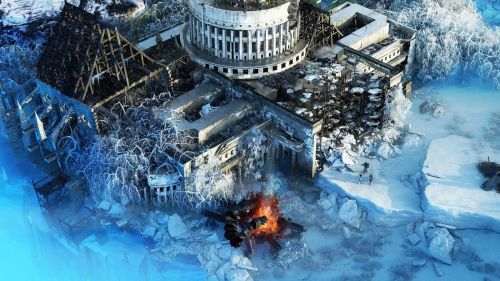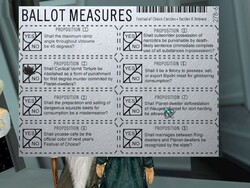Wasteland 3 Fig Update #11: Designing an RPG Town
Wasteland 3 Fig Update #11: Designing an RPG Town
Game News - posted by Infinitron on Mon 31 October 2016, 21:44:20
Tags: George Ziets; inXile Entertainment; Wasteland 3With the Wasteland 3 Fig campaign three days away from its conclusion, inXile seem to be making an effort to up the quality of their updates. In today's update, George Ziets writes at length about his process for designing town areas, offering a glimpse at the sort of quests Wasteland 3 will have. It sounds like the game will have a more Tormenty structure, with the city of Colorado Springs serving as a central hub. Here's an excerpt, along with a new concept render from the Bischoff brothers:
By the time the brainstorming phase is finished, I’ve hopefully got enough ideas to fill up the town, at least for a first pass. If the city is large enough to have multiple districts and interior locations, I typically have ideas for most of them at this point. The third phase is getting everything down on paper, old-school, Dungeons-and-Dragons style. I start drawing overview maps of the city and the districts, noting where important characters, locations, and quests could be.
A critical element during this phase is the main story. I need to know what story events take place in the town so I can decide where to place them. The main story should help guide the player through an RPG city. It should never lead the player by the nose to every point of interest, but major story events should be placed in different districts, giving the player a gentle nudge to explore at least some of them. Beyond that, it should be up to the player to explore and discover the rest of the content on their own.
If the city does have different districts, I try to give each one a unique flavor of its own. I ask myself about the kinds of people who live there (e.g., social class, native vs. immigrant), the purpose of the district (e.g., industrial, mercantile, residential), architectural style, and unique locations and monuments. The latter are especially important. When placed strategically around a scene, monuments, unique locations, and other visual features can help the player orient themselves and navigate through the area.
For example, in a district dominated by the Gipper faction, we might use landmarks like an old oil drilling tower, a statue of President Reagan, or a tall flagpole with Old Glory flapping in the wind. In a city like Colorado Springs, we’d also try to include real-world landmarks in scenes, like the Olympic Committee Headquarters and its unique metal sculptures, pictured below.
Narratively, I try to give each district a primary story (and sometimes a secondary story as well), just as I would for an adventure area out in the world. What are the main concerns of the people in the district? What problem (or problems) are they facing, and how might the player get involved? Not every NPC needs to be focused on the district’s main story or stories, but they should at least make reference to them, and their stories and quests should make sense within the larger context so that the area feels like a unified whole.
As a hypothetical example, imagine a secluded district of Colorado Springs that has become home to several retired or displaced warlords from the Plains. One of those warlords wants to take back his former territory, and he’s begun hiring thugs to build an army. The other warlords want to live out their retirements without attracting attention, so they’re trying to stop him, one way or another. Meanwhile, NPCs in the district are all affected by this story. Local people are being harassed by thugs who want to join the new army. Old enemies and aggrieved victims are constantly arriving in the district to exact their revenge on one warlord or another. A hotel manager is trying to evict a warlord who has run out of money (without getting killed by his bodyguards). And so on.
If the city is a hub – someplace the player will revisit multiple times over the course of the game (like Athkatla in Baldur’s Gate 2) – I need to think about how it will change as the game progresses. What events will take place later in the game? What stories will develop further, based upon the player’s actions? How will the city change? What characters will arrive in town? Usually, changes to the town should be visible from major pathways that players are likely to use. If they’re hidden in corners the player has no reason to visit again, they may never be seen (unless the player is pointed to them by some other NPC or quest). In WL3, Colorado Springs will probably be a hub city that the player will visit multiple times, so when we design it, we’ll be thinking carefully about how its content will change over the course of the game.
Cool stuff. If they keep releasing updates like this one, I'm going to have to make the campaign ending newspost a bit less negative.A critical element during this phase is the main story. I need to know what story events take place in the town so I can decide where to place them. The main story should help guide the player through an RPG city. It should never lead the player by the nose to every point of interest, but major story events should be placed in different districts, giving the player a gentle nudge to explore at least some of them. Beyond that, it should be up to the player to explore and discover the rest of the content on their own.
If the city does have different districts, I try to give each one a unique flavor of its own. I ask myself about the kinds of people who live there (e.g., social class, native vs. immigrant), the purpose of the district (e.g., industrial, mercantile, residential), architectural style, and unique locations and monuments. The latter are especially important. When placed strategically around a scene, monuments, unique locations, and other visual features can help the player orient themselves and navigate through the area.
For example, in a district dominated by the Gipper faction, we might use landmarks like an old oil drilling tower, a statue of President Reagan, or a tall flagpole with Old Glory flapping in the wind. In a city like Colorado Springs, we’d also try to include real-world landmarks in scenes, like the Olympic Committee Headquarters and its unique metal sculptures, pictured below.
Narratively, I try to give each district a primary story (and sometimes a secondary story as well), just as I would for an adventure area out in the world. What are the main concerns of the people in the district? What problem (or problems) are they facing, and how might the player get involved? Not every NPC needs to be focused on the district’s main story or stories, but they should at least make reference to them, and their stories and quests should make sense within the larger context so that the area feels like a unified whole.
As a hypothetical example, imagine a secluded district of Colorado Springs that has become home to several retired or displaced warlords from the Plains. One of those warlords wants to take back his former territory, and he’s begun hiring thugs to build an army. The other warlords want to live out their retirements without attracting attention, so they’re trying to stop him, one way or another. Meanwhile, NPCs in the district are all affected by this story. Local people are being harassed by thugs who want to join the new army. Old enemies and aggrieved victims are constantly arriving in the district to exact their revenge on one warlord or another. A hotel manager is trying to evict a warlord who has run out of money (without getting killed by his bodyguards). And so on.
If the city is a hub – someplace the player will revisit multiple times over the course of the game (like Athkatla in Baldur’s Gate 2) – I need to think about how it will change as the game progresses. What events will take place later in the game? What stories will develop further, based upon the player’s actions? How will the city change? What characters will arrive in town? Usually, changes to the town should be visible from major pathways that players are likely to use. If they’re hidden in corners the player has no reason to visit again, they may never be seen (unless the player is pointed to them by some other NPC or quest). In WL3, Colorado Springs will probably be a hub city that the player will visit multiple times, so when we design it, we’ll be thinking carefully about how its content will change over the course of the game.
There are 9 comments on Wasteland 3 Fig Update #11: Designing an RPG Town














